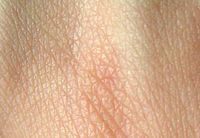
Patient‐derived in vitro skin models for investigation of small fiber pathology
Sign Up to like & getrecommendations! Published in 2019 at "Annals of Clinical and Translational Neurology"
DOI: 10.1002/acn3.50871
Abstract: To establish individually expandable primary fibroblast and keratinocyte cultures from 3‐mm skin punch biopsies for patient‐derived in vitro skin models to investigate of small fiber pathology. read more here.
Keywords: derived vitro; skin models; vitro skin; small fiber ... See more keywords

Safety assessment of cosmetics by read across applied to metabolomics data of in vitro skin and liver models.
Sign Up to like & getrecommendations! Published in 2021 at "Archives of toxicology"
DOI: 10.1007/s00204-021-03136-7
Abstract: As a result of the cosmetics testing ban, safety evaluations of cosmetics ingredients must now be conducted using animal-free methods. A common approach is read across, which is mainly based on structural similarities but can… read more here.
Keywords: vitro skin; safety; toxicity; div665 ... See more keywords

Construction of 3D multicellular microfluidic chip for an in vitro skin model
Sign Up to like & getrecommendations! Published in 2017 at "Biomedical Microdevices"
DOI: 10.1007/s10544-017-0156-5
Abstract: Current in vitro skin models do not recapitulate the complex architecture and functions of the skin tissue. In particular, on-chip construction of an in vitro model comprising the epidermis and dermis layer with vascular structure… read more here.
Keywords: construction; vitro skin; model; skin chip ... See more keywords

A new photosafety screening strategy based on in chemico photoreactivity and in vitro skin exposure for dermally-applied chemicals.
Sign Up to like & getrecommendations! Published in 2019 at "Toxicology letters"
DOI: 10.1016/j.toxlet.2019.09.016
Abstract: This study involved an attempt to establish a new photosafety screening system for dermally-applied chemicals consisting of a reactive oxygen species (ROS) assay and an in vitro skin permeation test. The ROS assay was undertaken… read more here.
Keywords: photoreactivity; vitro skin; exposure; skin ... See more keywords

Mechanistic Modeling of In Vitro Skin Permeation and Extrapolation to In Vivo for Topically Applied Metronidazole Drug Products Using a Physiologically Based Pharmacokinetic Model.
Sign Up to like & getrecommendations! Published in 2022 at "Molecular pharmaceutics"
DOI: 10.1021/acs.molpharmaceut.2c00229
Abstract: Physiologically based pharmacokinetic (PBPK) modeling has increasingly been employed in dermal drug development and regulatory assessment, providing a framework to integrate relevant information including drug and drug product attributes, skin physiology parameters, and population variability.… read more here.
Keywords: skin permeation; stratum corneum; vitro skin; model ... See more keywords

Curcumin-loaded microemulsion: formulation, characterization, and in vitro skin penetration
Sign Up to like & getrecommendations! Published in 2023 at "Drug Development and Industrial Pharmacy"
DOI: 10.1080/03639045.2023.2182121
Abstract: Abstract Objective Formulation of curcumin in a microemulsion with a high loading capacity and that favors its penetration into the skin. Significance Take advantage of the properties of microemulsions to promote the penetration of curcumin… read more here.
Keywords: microemulsion; formulation; vitro skin; penetration ... See more keywords

Cerium nitrate stiffens in-vitro skin models and reduces Pseudomonas aeruginosa pathogenicity and penetration through skin models.
Sign Up to like & getrecommendations! Published in 2022 at "Advances in wound care"
DOI: 10.1089/wound.2022.0026
Abstract: OBJECTIVE Cerium nitrate (CeN) plus silver sulfadiazine (SSD) cream has been used for 40-plus years to manage burns. CeN produces a hardened eschar believed to resist bacterial colonization/infection. To evaluate this potential mechanism, we treated… read more here.
Keywords: skin models; skin; vitro skin; penetration ... See more keywords

Radiation-induced alterations in multi-layered, in-vitro skin models detected by optical coherence tomography and histological methods
Sign Up to like & getrecommendations! Published in 2023 at "PLOS ONE"
DOI: 10.1371/journal.pone.0281662
Abstract: Background Inflammatory skin reactions and skin alterations are still a potential side effect in radiation therapy (RT), which also need attention for patients’ health care. Method In a pre-clinical study we consider alterations in irradiated… read more here.
Keywords: skin models; skin; vitro skin; coherence tomography ... See more keywords

Improvement of a Three-Layered in vitro Skin Model for Topical Application of Irritating Substances
Sign Up to like & getrecommendations! Published in 2020 at "Frontiers in Bioengineering and Biotechnology"
DOI: 10.3389/fbioe.2020.00388
Abstract: In the field of skin tissue engineering, the development of physiologically relevant in vitro skin models comprising all skin layers, namely epidermis, dermis, and subcutis, is a great challenge. Increasing regulatory requirements and the ban… read more here.
Keywords: vitro skin; skin; model; skin model ... See more keywords

In Vitro Skin Co-Delivery and Antibacterial Properties of Chitosan-Based Microparticles Containing Ascorbic Acid and Nicotinamide
Sign Up to like & getrecommendations! Published in 2022 at "Life"
DOI: 10.3390/life12071049
Abstract: Vitamins are widely found in nature, for example, in plants and fruits. Ascorbic acid and nicotinamide are examples of these compounds that have potent antioxidant properties, besides stimulating collagen production and depigmenting properties that protect… read more here.
Keywords: containing ascorbic; microparticles containing; vitro skin; ascorbic acid ... See more keywords